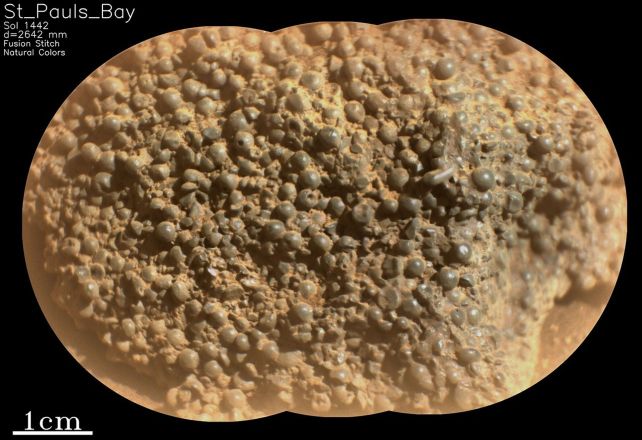[ad_1]
Once again, Mars has presented us with an example of something it seems to have in abundance: extremely peculiar and baffling rocks.
As the Perseverance rover trundled about Broom Point, on the lower slopes of Witch Hazel Hill on the rim of Jezero Crater, it came across a rock that looks all bubbly and weird, like a deposition of frogspawn. It consists of hundreds of tiny dark gray spherules, each a millimeter or so across, all clumped together in a formation.
Scientists have named the rock St. Pauls Bay, and described it as “shocking”. There’s nothing else like it in the surrounding area; what it’s made of, how it formed, and how it got there are all mysteries.

Crystalline minerals comprising clusters of spheres are known as botryoidal formations here on Earth, and it’s common for many minerals, with a well-understood formation mechanism.
How such formations come together on Mars, however, may be very different indeed – especially since St. Pauls Bay appears somewhat dissimilar from terrestrial botryoidal formations, such as grape agate or hematite.
Another way tiny spherules can form is from molten rock that cools rapidly. This process can happen during a meteorite impact, when the heat of the collision between meteorite and ground melts globules of material and sends them flying, and also during volcanic activity.
Several spherical rocks have been found on Mars. Tiny spheres nicknamed “blueberries” are concretions of hematite-rich material that form in the presence of water. Bubbly “popcorn” rocks in the Jezero crater are also thought to have formed in the presence of water. Tiny round spherules found in the Gale crater by the Curiosity rover have also been interpreted as aqueous concretions.

The formation mechanism of St. Pauls Bay is currently impossible to determine. That’s because it’s what is known as a float rock – one that ‘floats’ above the bedrock, having been somehow transported from its original location.
Because we don’t know where St. Pauls Bay comes from, the context in which it formed is unknown – vital information for determining whether fire or water produced the strange clump of teeny tiny balls.
Observations taken from orbit, however, have identified a nearby dark layer of rock that may have been the birthplace of St. Pauls Bay. All we need now is for Perseverance to sidle a bit closer and take a gander.
[ad_2]
Source link




